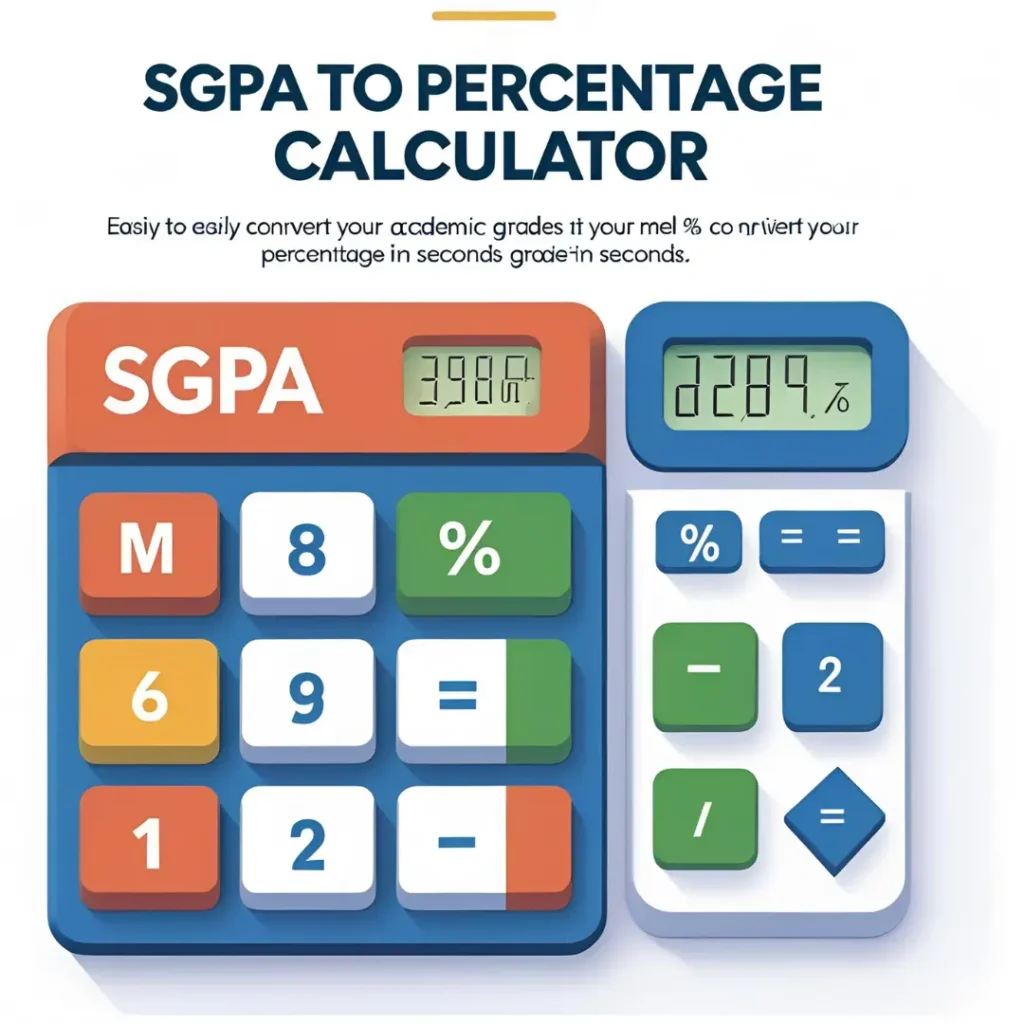

But here’s the catch: while SGPA looks great on a university transcript, most employers, foreign universities, and even government forms still expect to see your percentage. That’s why understanding the difference between SGPA, CGPA, and GPA, and knowing how they convert, becomes absolutely essential.
If you need to convert your overall cumulative GPA, use our CGPA to Percentage Calculator for accurate results.
Whether you’re aiming for campus placements, higher studies abroad, or applying through CBSE or state boards, understanding grade conversions works both ways. Need to convert the other direction? Our Percentage to CGPA Calculator helps when universities require CGPA from your percentage marks


Example:
If your SGPA is 8.2, then
(8.2 × 10) – 7.5 = 74.5%
To save time and avoid manual math, you can use our SGPA Percentage Calculator in just a few easy taps:
This tool is built to support SGPA conversion in India and other neighboring countries across major grading formats, so you always get the right result, fast.
For quick results, use the live calculator above, it’s tailored for Indian students and supports all standard grading scales.

While the calculator simplifies everything, it’s still empowering to know how to convert SGPA without a calculator. This helps build clarity and confidence—especially when you’re double-checking results or learning how different Indian universities calculate SGPA to percentage manually.
Let’s explore real formula examples from popular universities in India:
Formula: (SGPA – 0.75) × 0
If SGPA = 8.4, then:
(8.4 – 0.75) × 10 = 76.5%
Formula: (SGPA – 0.75) × 10
If SGPA = 8.0, then:
(8.0 – 0.75) × 10 = 72.5%
Formula: (SGPA × 10) – 7.5
If SGPA = 8.3, then:
(8.3 × 10) – 7.5 = 75.5%
Formula (Range-Based):
If SGPA = 7.5 → falls in the 6.75–8.25 range
Formula: (10 × SGPA) – 7.5 → (10 × 7.5) – 7.5 = 67.5%
Formula: Not a direct formula; uses a mapping table.
If SGPA = 8.25, based on official table → 75%
These manual formulas reflect how universities actually calculate your final marks. And while it’s helpful to understand the math.
The most commonly accepted SGPA to percentage formula in India is (SGPA × 10) – 7.5. However, many universities like JNTU, VTU, and SPPU follow their own conversion systems. Always check your university's official grading policy before applying a general formula. For quick and accurate results, use our SGPA to percentage calculator.
To convert SGPA without a calculator, use your university’s official formula. A general method is:
Percentage = (SGPA × 10) – 7.5
But universities like MAKAUT and SPPU use custom conversions. Always factor in credit weight and grading scale. You’ll find manual examples for various universities in our detailed guide above.
Universities like JNTU, VTU, AKTU, SPPU, and MAKAUT follow distinct SGPA to percentage conversion formulas. Some use range-based methods, others use tables or institutional grade point logic. That’s why it's critical to avoid assuming a one-size-fits-all formula.
No, SGPA (Semester Grade Point Average) and CGPA (Cumulative Grade Point Average) are not the same. SGPA refers to a single semester’s performance, while CGPA averages all semesters. Each may use a different conversion formula. This article focuses strictly on SGPA to percentage conversion. For CGPA, use our dedicated CGPA to percentage calculator.
Most Indian employers still ask for percentage instead of SGPA, especially for government jobs, campus placements, and postgraduate programs. While universities issue SGPA, it's your responsibility to convert it accurately using the correct method. This makes using a verified SGPA percentage calculator essential for eligibility.
Using the wrong SGPA to percentage formula can result in a miscalculated percentage, potentially disqualifying you from exams, interviews, or international admissions. For instance, using (SGPA × 10) – 7.5 for a university like SPPU may lead to a significant error. Always verify your formula based on your institution’s grading system.
Yes. Our SGPA to percentage calculator supports India’s major grading scales, 10.0, 5.0, and 4.0, making it compatible with most universities including VTU, AKTU, SRM, and JNTU. It's built to adapt to common academic standards and is regularly updated to reflect institutional changes.
Copyright © 2025 cgpapercentage.online